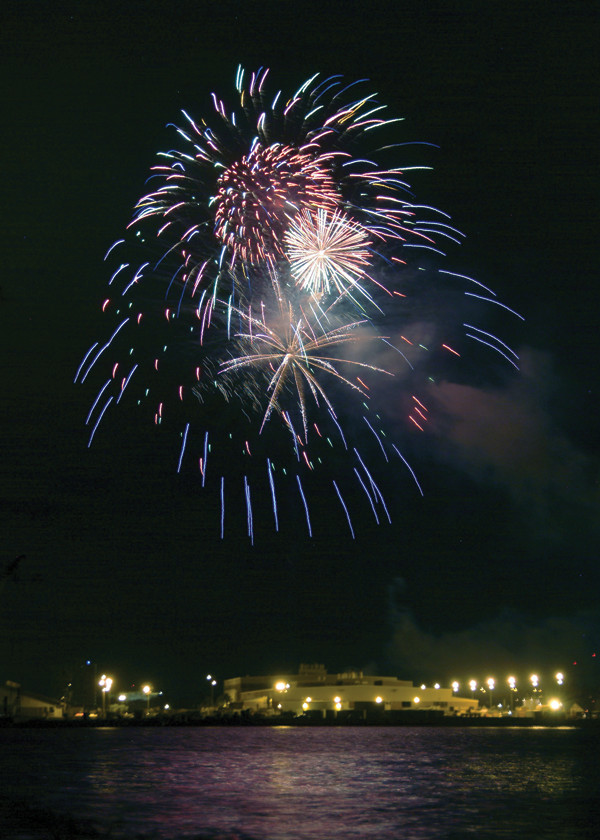
by U.S. Geological Survey Monday, December 8, 2014
Joyce Ober, mineral commodity specialist for the U.S. Geological Survey, prepared the following information about strontium, the element that gives fireworks their bright red color.

Strontium creates the brilliant red in this fireworks display, whereas a combination of strontium and copper creates the purple coloration. Credit: U.S. Navy photo by Chief Mass Communication Specialist David Rush.
Strontium occurs commonly in nature, ranking as the 15th most abundant chemical element on Earth. Only two minerals contain sufficient strontium, however, to be used commercially to produce strontium compounds: Strontianite (strontium carbonate) has a higher strontium content, but celestite (strontium sulfate) is by far the most abundant strontium mineral.
Virtually all strontium compounds are processed from celestite. Because celestite commonly occurs with barium and calcium minerals with similar properties — making the separation process difficult — most strontium compound producers require raw celestite to contain at least 90 percent strontium sulfate. The operating deposits, however, contain such high-grade material that minimal processing is typically required to meet this specification. Most operations employ hand sorting and washing, with only a few using froth flotation or gravity separation to concentrate the ore.
Deposits of high-grade celestite have been identified in China, Mexico and Spain, but detailed information on most of these deposits is not readily available. Many of the deposits are in remote, sparsely inhabited areas where little formal exploration has been done. Other deposits may be well delineated, but are in countries from which specific mineral information is not easily obtained, such as Iran and Tajikistan.
Strontium carbonate was used in faceplate glass to block X-ray emissions from color cathode ray tubes (CRTs) in older-model televisions. At the peak of its use in television glass, as much as 75 percent of U.S. strontium consumption was used in CRTs. With the increasing use of flat panel displays, however, the strontium industry has experienced a dramatic decline. No strontium minerals have been produced in the United States since 1959.
Today, the leading uses of strontium compounds are in ceramic ferrite magnets, pyrotechnics and signal flares. Strontium ferrite magnets are commonly used in small motors, loudspeakers, electronics and toys because of their favorable magnetic properties and low cost. Strontium can also be used in electrolytic production of zinc, as a corrosion inhibitor in paint and to improve castability in aluminum alloys.
Celestite is typically used as the raw material in strontium carbonate production. Anecdotal reports suggest that recent increases in celestite imports — which are 10 times what they were in 2010 — may be the result of the mineral being substituted for barite in drilling fluids used in natural gas and crude oil wells, but this has not been verified because oil and gas companies treat the contents of the fluids they use as proprietary information.
For more information on strontium and other mineral resources, visit: minerals.usgs.gov/minerals.
World strontium production peaked in 2005 at 525,000 metric tons, then declined to 219,000 metric tons in 2010, and has since increased again.
Five countries reported production of celestite in 2013: China, Spain, Mexico, Argentina and Morocco.
In 2013, U.S. consumption of strontium was 29,100 metric tons, 24 percent less than in 1997 when strontium consumption peaked at 38,300 metric tons.
When U.S. strontium consumption peaked, it was used in a wide variety of compounds; in 2013, 75 percent was consumed as unprocessed celestite.
Strontium nitrate burns with a bright red flame, making it a desirable component of fireworks, signal flares and tracer bullets.
Strontium 90, a radioactive strontium isotope, is a product of nuclear reactions but is not found in nature.
The strontium mineral strontianite was discovered in Scotland in 1790 near the village of Strontian, for which the mineral and element were named.
© 2008-2021. All rights reserved. Any copying, redistribution or retransmission of any of the contents of this service without the expressed written permission of the American Geosciences Institute is expressly prohibited. Click here for all copyright requests.